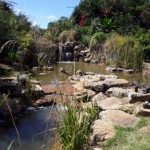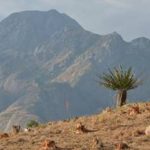TREE LIFE
July 2021
Because of recent upsurge in Covid 19 cases the planned outings for the Tree Society have had to be cancelled. This was a huge disappointment as we had planned to go further afield, however, we hope to get another invitation to Darwendale and to Margie Tredgold. This must be really tedious for you Ann!!
In the meantime, all Tree Society outings have been cancelled.
It is with great sadness that we record the death of Alex Masterson on 24th June, 2021. With him has gone a wealth of knowledge, he will be sadly missed by all who knew him.
NATIONAL BOTANIC GARDEN WALK 1ST MAY 2021
We had a poor turnout with only Dawn Siemers, Meg Coates Palgrave, Mark Hyde, Jim Dryburg, Marina Mason and myself present. Perhaps it was the wet conditions resulting from the rains during the night that put people off or perhaps because it was Mayday.
I wanted to see the small Diospyros squarrosa. Rigid star-apple (the name refers to the stiff leaves which I had seen about a month ago which had a lot of fruit on and Meg wanted to see the Acacia grandicornuta. Horned thorn so we headed off in that general direction only to be distracted by a few trees en route.
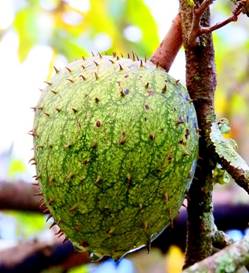
Annona muricata fruit. Photo: Jim Dryburgh
We looked at the Ficus ottonifolia subsp. macrosyce trees which always appear to have figs at any time of the year – the figs look like bird eggs! We then looked at the Tara spinosa (Caesalpinia spinosa) which had already flowered and all four trees were in fruit. Within the commercial section we looked at several trees including a custard apple tree that had weird looking flowers on the trunk as well as between the leaves. The Annona muricata. Soursop had some spiky fruit.
Further on where we have an “island” of trees, we noted that the spectacular Cordia ovalis. Sandpaper cordia had died and Lantana camara had taken over. A bit further on we looked at a tree with blue coloured branches – it’s always good to see the Commiphora caerulea! It was leafless (except for a couple of new shoots) but it does photosynthesize through its blue branches.
On seeing the Diospyros squarrosa, the fruit looked just like it had about a month ago – it had not ripened at all! Not far from this waist high tree was another D. squarrosa without any sign of fruit. We next looked at the Acacia grandicornuta which has small leaflets on only two or three pairs of pinnae – the short rachis is noticeably grooved (has a channel) on top. This acacia is indigenous but is only to be found in the South Eastern corner of Zimbabwe.
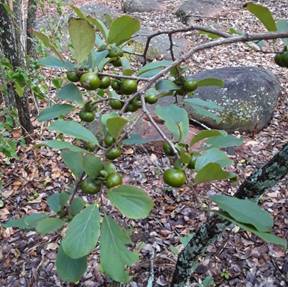
Diospypros squarrosa. Photo: Tony Alegria
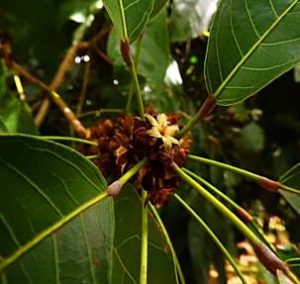
Cola greenwayi. Photo: Jim Dryburgh
On the way back we came across an Artabotrys brachypetalus. Purple hook-berry in fruit, some ripe and some green. We sampled the fruit but they didn’t have much flesh and can only be enjoyed by someone who is really hungry. We also saw the Cola greenwayi. Hairy cola in flower.
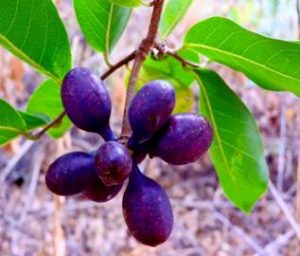
Artabotrys brachypetalus ripe fruit. Photo: Jim Drybrugh
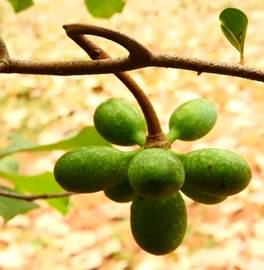
Artobotrys brachypetalus green fruit. Photo: Jim Drybrugh
So ended the very enjoyable morning tree walk. I always find that the smaller the group, the more interaction there is which makes the outing more special.
-Tony Alegria
OF MINE REGENERATION, MARULAS AND COFFEE
On Sunday 16th March about 30 members walked over the Golden Quarry Hill on Warren Farm on the Bulawayo Road. The hill is of banded ironstone and rises to an altitude of 4950 feet A.S.L. approx. 150” above the surrounding plain. Regeneration in the area has been good since the mine stopped working. We noted over 40 species of particular interest being Monotes ungleri and tall Ochna puberula (about 15”), a very nice colony, evenly distributed on hill and slopes of Tapiphyllm velutinum, some of which bore ripe fruit, and we noted that the bark of this plant was very distinctive, coming away in thick flaky layers. Mukwa (Pterocarpus angolensis) became more frequent on top of the hill. One nice young violet tree (Securidaca longepedunculata) was found also on the top.
The fact that the more varied and interesting vegetation was found higher on the hill probably reflects the fact that the rock on the higher ground give considerable protection from the annual burn which is very fierce lower down.
Miss Isabel McCalman of Matabeleland Branch writes to comment on the March newsletter – “Marula kernels when I was travelling Matabeleland for the Federation of African Women’s’ Clubs in 1963/64, the American ladies of the Brethren of Christ Missions at Mtshabezi and Wanezi Missions used to regale me with the most delightful sponge cakes with fillings of surface coatings, consisting mainly of marula kernel crumbs, such adjuncts making a confectionery out of this world”.
Simply eating plain kernels was a delight all too infrequently experienced, and this is easily understood when one attempts to remove the kernels from the nuts. Ordinary nut crackers are of little use, either making no impression or shattering the whole nut and kernels, hammering on an anvil had much the same result. Some success came from squeezing a vice and picking out the ‘eyes’ with a nail. Arduous work to produce three small nutlets!
This makes it easy to understand why the supply of even a small number of kernels is not found often – especially when it is noted that removal of kernels is usually performed by old grandmothers sitting on granite dwalas and leisurely hammering away at nuts with some suitable stone and picking out the kernels with large mimosa thorns. In the early sixties, those old “gogos, if found, might be persuaded to sell one cupful, a day’s work for 6 pennies.
Bearing in mind that these kernels were a delicacy to those toothless old women, it was easy to understand why so few came on the market as additionally they were also used in the preparation of vegetable relishes, kernels were used as candles, and were part of every woman’s cosmetic requirements.
Recently I have been told of, but have not yet tried, an easier (and I use the word circumspectly) was of extraction involving boiling.
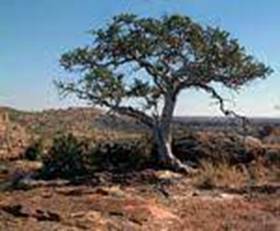
Boscia ablitrunca Source: Flora of Zimbabwe
Boscia albitrunca regrettably this species is not found in the Matopos/Essexvale area but many trees are seen in the basaltic areas around Nyanyadzi near Birchenough Bridge and across the lower Msingwane Bridge south of Manama Mission. It is well known to farmers in the Transvaal who have frequently used the roots which they dry, pound in mortars, grind and roast to produce coffee substitute.
In times of famine people in the Manama and Kezi areas dig the smaller roots, split them into suitable sizes, dry in the sun, pound and then grind the dry material to make an extremely nutritious porridge. Possibly this is not more commonly prepared because of the labour entailed, and the relatively small amount of roots available. In these areas with the general absence of good grazing, goats and cattle strip leaves, twigs and bark leaving the tree boles spectacularly bar and light coloured – hence the name “Witgatboom”.
(Taken from Tree Life Vol. 1, No. 1, April 1980)
DRONGOS, PINK FLOWERS AND A MYSTERY WOMAN
I first got to know our tree of the month around five years ago. I suppose I have the square-tailed drongos to thank for that.
It was in Mutare, where we lived in a house that was up near the Cecil Kop mountain range. I took daily walks along the fence that surrounded the nature reserve.
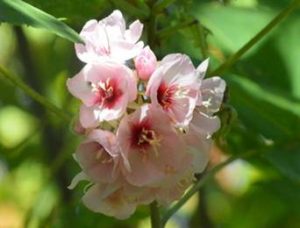
The rose-pink flowers emerge during the winter. Photo; Ryan Truscoott
One evening I heard a commotion in a shrub that was covered in delicate pink flowers.
The ruckus was caused by those rugger-buggers of the avian world: square-tailed drongos. When they get into fights with other birds their strident calls remind me of the rugby chant: “Oggy, oggy, oggy. Oi, oi oi.” And like their cousins — the fork-tailed drongos — they have fiery red eyes and temperaments to match.
I never discovered who the drongos were fighting with that day, but I did get to identify the tree they were in. It was a Pink dombeya, Dombeya burgessiae.
The tree has grape-like leaves that are reportedly much-loved by black rhinos throughout its range, which extends from KwaZulu-Natal through Tanzania and Rwanda and up into Uganda.
The really eye-catching feature of the tree though, as my encounter with the drongos proved, is the profusion of pink flowers.
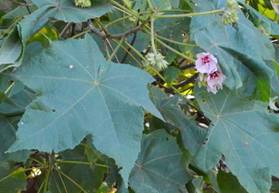
Gardeners love the Pink dombeya’s grape-like leaves . Photo: Ryan Truscott
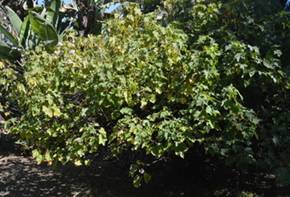
The Pink dombeya is really a bushy shrub. Photo: Ryan Truscott
When we moved to Harare four years ago, we were delighted to discover a number of Pink dombeyas growing in the garden of the house we had found to rent.
It was August and the dombeyas were still in flower. It was like a home away from home.
My wife loves the flowers and puts them in vases around the house, or on the table outside at lunchtime on Saturdays.
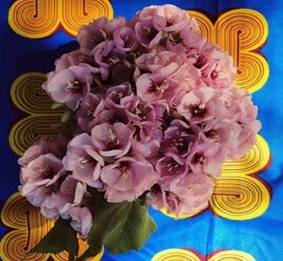
Dombeya flowers gracing the lunch table. Photo:Kate Truscott
I decided to get in touch with South African-based writer and fellow Zimbabwean Mary Armour to find out if she knew more.
“You’re touching on an old mystery,” she told me, explaining that little more is known of “Miss Burgess of Birkenhead” than that she was a friend of the nineteenth century plant collector William T. Gerrard.
Gerrard collected trees, birds, insects and shells, mostly in Natal. He is commemorated in the names of more Natal plants than any other, according to one article in Natalia, the Journal of the Natal Society.
It said Gerrard eventually died from blackwater fever in 1872 on the eastern coast of Madagascar where he’d moved to from South Africa.
But as for Miss Burgess, the trail runs cold. “I wonder if Miss Burgess might have been a generous patron based in the UK,” said Mary. “I did come across a Miss Jane Amelia Burgess who exhibited flower paintings at the Royal Academy of the Arts in London, between 1843-1848.”
But there was nothing to connect that artist to Birkenhead, which is a town near Liverpool.
Before his untimely death Gerrard also named a fern in honour of Miss Burgess: Woodsia burgessiana. It’s a species found in Madagascar, Zimbabwe, South Africa and Lesotho.
Whoever she was, Miss Burgess was evidently “a lasting botanical influence,” Mary noted.
For me, the mystery over the person behind the Pink dombeya adds to the tree’s allure. In the meantime, I’ll enjoy the presence of its lovely blossoms in our home.
-Ryan Truscott
SALISBURY OUTING 20TH APRIL 1980
By kind permission of Mr. John Curtis, we stomped over his farm in the Mapfeni Valley on the Arcturus Road. Led by Dr. Ken Davy, we followed the tributary river line up into the low granite range, south of the homestead. Some members made it to the high point (above the 5 100’ contour), although most found the vegetation of the slopes, and especially of the stream bed, so interesting, that there was little incentive to push all the way to the top. The going near the top was made more difficult by the scratchy vegetation, including at least one stinging nettle which turned the tables, and effectively collected the writer, rather than vice versa.
A wide variety of trees were seen, of special mention in the gully riverine fringe, Osyris lanceolata in green fruit and a tall, very glabrous Faurea saligna, growing up to the light under a Syzygium cordatum canopy. Protea angolensis made a fine display of white flowers, and Pittosporum viridiflorum was heavy with fruit. I quickly skirted around the Euclea crispa in large yellow fruit, which turned out to be Diospyros lycioides, and pose the question : has any reader made the same observation as I have, that the mountain acacia Brachystegia glaucescens, does not seem to go above the 5 000’ contour, at least around Salisbury.
After a picnic lunch, we walked to an outlying granite hill about 150’ lower that the main ridge. We recorded only a few species here, not seen during the morning, but the panoramic view efrom the top was worthwhile.
75 species were recorded, including real Euclea crispa on the higher slopes.
As a follow up to the wonderful day we had on Sunday, Meg Coates Palgrave thought that those involved in the day’s unresolved arguments may like to know the conclusions, and adds the following to George Hall’s above summary.
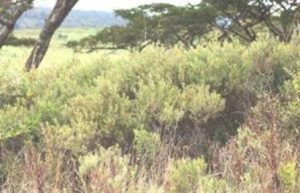
Euclea crispa. Photo: Bart Wursten
Source: Flora of Zimbabwe
“Our first find was Euclea crispa – a great excitement, until we found it bearing Diospyros lycioides fruit! While they both belong to the same family, EBANACEA, it is incredible that they can look so alike. Nearby were clumps of ? Rhus/Allophylus. I collected a specimen every time someone claimed “this” was different. All were finally identified as Rhus tenuinervis, showing all the variations from what we recognize as the familiar roundish furry leaves, to narrow, glabrous ones. In trying to establish how to identify this tree other than by instinct, it would appear that the leaflets of R.tenuinervis have a scalloped or toothed margin other than towards the base, where the margin is entire. The specimens had less entire margins than the books suggest.
The trifoliate leaved specimens with tufts of hairs in the vein axils, which was collected later, was Allophylus africanus. And, of course, what we thought was Rhus longipes, was just that.
Having seen Monotes engleri on our previous outing, we felt we were experts at identifying it. I am sure you will be glad to know that we were right, and that I brought back a specimen of M.glaber, with its yellow-green appearance and obovate, inverted egg, shaped leaves, and M.engleri looking incredibly like Parinari curatellifolia, with oval leaves with pale grey under surfaces.
In the stream, near the Bequaertiodendron magalismontanum, was what looked like a very fleshy Faurea saligna, and it turned out to be just that. I brought back a specimen, and a specimen of ordinary looking F.saligna, and when I looked at them at home, they both showed the same bruising and blackening resulting from being carried about in a plastic bag – further confirmation that they were the same.
The creeper with the palmate leaf, and lovely red fruit, frequently with a few empty ones lying on the ground robbed of their pips, is Cyphostemma gigantaphyllum. It is identified by the white dots or glands on the under surfaces of the leaves, quite visible to the naked eye. Fruits of other Cyphostemma are described as edible, so Douglas Irvine tried these. It was much too diffident to taste for comment.
The only Grewia I have ever found has been G.monticola, but Sunday proved the exception. Only after everyone commented that the “Grewia looked funny” did I check a bit in the bag. That proved to be G.micrantha, which has not been collected in the area previously. In fact, there are remarkably few specimens of it in the herbarium, so if anyone is out there again, please would they collect a decent specimen. The one I collected was on the top of the ‘morning’ kopje. The Grewia with the 4-lobed fruit found on the ‘afternoon’ kopje was G.stolzii. Fortunately the fruit is edible, for in cleaning the seed for planting I used my mouth. It has a pleasant, sweet taste, but was not very fleshy.
There was also a tree, very heavy with fruit, that we found completely unrecognisable. This was Euclea natalensis with clean leaves, much smaller than we usually see them.
And finally, although I did not collect any leaves of the “lucky beans”, what we collected were those of Erythrina latissima. I have started the process of getting them to grow.”
-Meg Coates Palgrave
Taken from Tree Life No. 2, May 1980
INTRODUCTION TO EUCALYPTUS TREES FAMILY : MYRTACEAE
“Gum Trees” as they are known to the Australians and many others around the world only became known late in the eighteenth century when Joseph Banks and Daniel Solander arrived at Botany Bay with Captain James Cook in 1770. In 1777, on Cook’s third expedition, David Nelson collected an eucalyptus which was taken to the British Museum in London and was named Eucalyptus obliqua by the French botanist L’Héritier, who was working in London at the time.
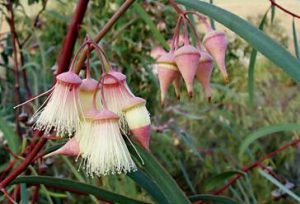
Photo from: Science.org.au
The name obliqua was derived from the Latin obliquus, meaning “oblique”, which is the botanical term describing a leaf base where the two sides of the leaf blade are of unequal length and do not meet the petiole at the same place. He coined the generic name from the Greek roots eu and calyptos, meaning “well” and “covered” in reference to the operculum, the flower bud which protects the developing flower parts as the flower develops and is shed by the pressure of the emerging stamens at flowering. It was most likely an accident that L’Héritier chose a feature common to all eucalypts. The photo below clearly shows the operculums being pushed off by the pressure of maturing stamens.
Most of us would think that all Eucalyptus trees are indigenous to Australia but that is not so as there are some 15 species to be found in neighbouring islands with 9 of them being non-Australian. The oldest definitive Eucalyptus fossils are from South America where eucalypts are no longer native. This shows that the genus had a Gondwanaland distribution. Fossil leaves also occur in the Miocene of New Zealand, where the genus is not native today. The modified map from Wikipedia indicating where the present indigenous Eucalypts are to be seen is shown below.
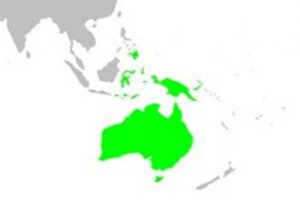
Natural Ecalyptus distribution part map from Wikipedia
Eucalypts occur in environments from l0°N to 44°S latitude and from sea level to 2000 metres elevation (snow line) and from 100 to 3,750 millimeters of rainfall. These vast differences in climate have allowed a great diversity to develop within the Eucalyptus genus. The inherent diversity has resulted in successful introduction of many of the species to countries which lie in tropical, subtropical and warm temperate zones of the world.
As with other plants and animals, introduction of eucalypts to areas of the world where they are not indigenous sometimes allows for performance that is greatly superior to that exhibited in their native habitat. Reasons for the differences in performance include favourable climatic conditions and the general lack of pests in the new environment. They are grown for timber, fibre, fuel, medicinal and ornamental purposes in many tropical and subtropical countries. Fibre is used in the manufacture of paper.
We would also think that the more than 700 species of eucalyptus are all pretty tall trees, but this is not the case. Eucalypts vary in size from shrubs to tall trees. Trees usually have a single main stem or trunk but many eucalypts are mallees that are multistemmed from ground level and rarely taller than 10 metres (33 feet). There is no clear distinction between a mallee and a shrub but in eucalypts, a shrub is a mature plant less than 1 m (3 ft 3 in) tall. These shrubs are normally found growing in an extreme environment e.g. on coastal cliffs in Western Australia. Tree sizes follow the convention of Small: up to 10 m in height, Medium-sized: 10–30 m, Tall: 30–60 m and Very tall: over 60 m
In most cases, many characteristics are used to identify the species of a tree which include: size, colour of crown, bark, leaf shape and colour, bud shape, number of buds in a cluster, flower colour and shape & size of fruit. The fruit is called a “Gum nut” and can be single or in clusters of 3s, 7s or 7plus, can even be more than 50!
All the information above came from Wikipedia and a book entitled Eucalyptus – An illustrated guide to identification by Ian Brooke and David Kleinig
SUBSRIPTIONS ARE NOW DUE
Our new financial year commenced on 1st April and subscriptions for the year ending 31st March 2022 are now due and payable.
Subs have been set at USD 5.00 per year per family and at present we are using an exchange rate of 120:1
Payment can be made in USD directly to our Chairman, Tony Alegria, or in ZWL$ to our CABS account, or via Ecocash.
If paying to our CABS account the amount is ZWL$ 600.00, and the account details are as follows: CABS Account Name: W.R.Clarke – Tree Society
Account Number : 1002549477 $600.00
If you are paying by Ecocash you will need to pay ZWL$640 to cover the costs associated with Ecocash.
Ecocash – Registered recipient – W.R.Clarke – Phone number 0772252720 $640.00
Whichever means you use to pay your subs, please notify Bill Clarke by email at wrc@mweb.co.zw once you have paid. Proof of payment is not needed.
CHAIRMAN TONY ALEGRIA


